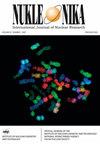Computer-simulated degradation of CF3Cl, CF2Cl2, and CFCl3 under electron beam irradiation
IF 0.3
4区 物理与天体物理
Q4 CHEMISTRY, INORGANIC & NUCLEAR
引用次数: 0
Abstract
Abstract Electron beam treatment technologies should be versatile in the removal of chlorofluorocarbons (CFCs) owing to their exceptional cross sections for the thermal electrons generated in the radiolysis of air. Humidity, dose rates, O2 concentration, and CFC concentration influence the efficiency of the destruction process under electron beam treatment. Computer simulations have been used to theoretically demonstrate the destruction of chlorotrifluoromethane (CF3Cl), dichlorodifluoromethane (CF2Cl2), and trichlorofluoromethane (CFCl3) in the air (N2 + O2: 80% + 20%) in room temperature up to a dose of 13 kGy. Under these conditions, it is predicted that the removal efficiency is in the order CF3Cl (0.1%) < CF2Cl2 (7%) < CFCl3 (34%), which shows the dependence of the process on the number of substituted Cl atoms. Dissociative electron attachment with the release of Cl– is the primary process initiating the destruction of CFCs from the air stream. Reactions with the first excited state of oxygen, namely, O(1D), and charge-transfer reactions further promote the degradation process. The degradation products can be further degraded to CO2, Cl2, and F2 by prolonged radiation treatment. Other predicted products can also be removed through chemical processes.电子束辐照下CF3Cl、CF2Cl2和CFCl3的计算机模拟降解
摘要电子束处理技术在去除氟氯化碳(CFCs)方面应该是通用的,因为它们对空气辐解过程中产生的热电子具有特殊的横截面。湿度、剂量率、O2浓度和CFC浓度影响电子束处理下破坏过程的效率。计算机模拟已用于从理论上证明在室温下,高达13kGy的剂量下,空气(N2+O2:80%+20%)中的三氟氯甲烷(CF3Cl)、二氯二氟甲烷(CF2Cl2)和三氟三甲烷(CFCl3)的破坏。在这些条件下,预测去除效率为CF3Cl(0.1%)
本文章由计算机程序翻译,如有差异,请以英文原文为准。
求助全文
约1分钟内获得全文
求助全文
来源期刊

Nukleonika
物理-无机化学与核化学
CiteScore
2.00
自引率
0.00%
发文量
5
审稿时长
4-8 weeks
期刊介绍:
"Nukleonika" is an international peer-reviewed, scientific journal publishing original top quality papers on fundamental, experimental, applied and theoretical aspects of nuclear sciences.
The fields of research include:
radiochemistry, radiation measurements, application of radionuclides in various branches of science and technology, chemistry of f-block elements, radiation chemistry, radiation physics, activation analysis, nuclear medicine, radiobiology, radiation safety, nuclear industrial electronics, environmental protection, radioactive wastes, nuclear technologies in material and process engineering, radioisotope diagnostic methods of engineering objects, nuclear physics, nuclear reactors and nuclear power, reactor physics, nuclear safety, fuel cycle, reactor calculations, nuclear chemical engineering, nuclear fusion, plasma physics etc.
联系我们:info@booksci.cn
Book学术提供免费学术资源搜索服务,方便国内外学者检索中英文文献。致力于提供最便捷和优质的服务体验。
Copyright © 2023 布克学术 All rights reserved.
京ICP备2023020795号-1
 京公网安备 11010802042870号
京公网安备 11010802042870号
京ICP备2023020795号-1

Book学术文献互助群
群 号:604180095

 求助内容:
求助内容: 应助结果提醒方式:
应助结果提醒方式:
